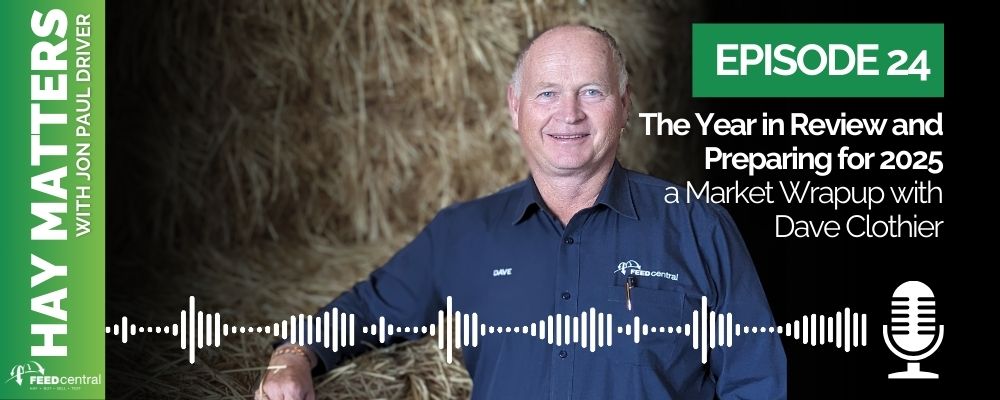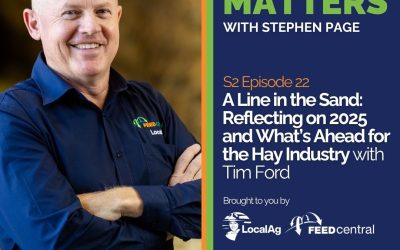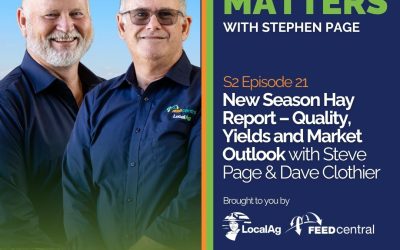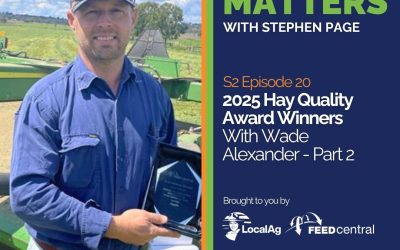
Podcast Highlights
In the final Feed Central Hay Matters Podcast for 2024, Jon Paul Driver catches up with National Sales Manager Dave Clothier to discuss the challenges and market shifts faced by hay producers during the 2024 season and what we can expect in the year ahead.
Early in the year, drought cleared stockpiles of low-grade hay, but wet weather later reduced overall production and caused quality deterioration. Strong demand continues, driven by record feedlot numbers and booming beef exports, while the sheep flock declines and the dairy sector remains cautious. Looking ahead, hay prices are expected to rise, with limited availability of high-quality supply for key demand periods. Forward planning is essential as 2025 brings new opportunities and challenges.
The Year that’s Been:
- Early drought in southern Australia cleared stockpiles of low-grade hay from previous seasons.
- Variable spring and summer conditions has either reduced hay yields or impacted quality, while frost events produced some high-quality hay in far smaller volumes than expected.
- Current stockpiles are mostly mid-grade hay, with limited availability of premium fodder needed for the March–April weaning period.
- Feedlot numbers are at record highs of 1.4 million cattle, with strong confidence feedlots will remain full throughout 2025.
- Australian beef exports reached a record-breaking 1.3 million tonnes, driven by strong demand from Japan, Indonesia, and the US.
Looking Ahead:
- National sheep flock is declining due to drought, live export policy changes in Western Australia, and challenging weather conditions across southern production regions.
- The dairy sector faces reduced milk production, fluctuating weather, and budget pressures, leading to more cautious fodder purchasing decisions.
- Hay prices are predicted to rise by at least 10% in early 2025 due to limited supply, grower cash flow priorities, and strong demand.
- Forward contracting is recommended to secure quality hay and manage costs before peak demand periods.
Read Transcript
Jon Paul Driver 0:00
Welcome to the Feed Central Hay Matters podcast. I’m your host, Jon Paul driver, today on the podcast, I’m joined again by Dave Clothier. Dave is the National Sales Manager for Feed Central. Welcome back. Thanks.
Dave Clothier 0:18
JP, great to catch up with for the last time of 2024 been a very interesting year.
Jon Paul Driver 0:25
What makes you say interesting? It’s expected in
Dave Clothier 0:29
Australia, but it is a large continent, and there’s challenges every year for some people across the across this great nation, and this year’s been no different to the others. There has been significant challenges, I suppose, from drought to fire to flood to everything that we get used to over
Jon Paul Driver 0:47
here, you just get it all, don’t you?
Dave Clothier 0:50
We do it’s it’s really surprising when I look back and just thinking about this conversation we’re having, and I rewind back to January, 2024 and where we were then, and where we were then was, you know, the stockpile was considerable, and there was a lot of low grade hay in the system from 2022 and everyone was concerned of how we’re going to move it And what’s going to happen. And it’s just amazing that, you know, a drought in one part of the country, in which case was the southern part of Australia, South Australia, actually Western Australia as well South Australia, large part of Vic and Tasmania, all had a drought. And hey presto, in a few months, the stockpile was largely gone consumed. So that solved that problem, and it certainly created an opportunity to clean the sheds out and prepare for new season, which is always a challenge. But, you know, clearing the stockpile was, it was a great thing to be done. And then, you know, as we progress through the year, there was a good spring break, and there’s been follow up rain since through the eastern seaboard, largely still some challenges in in parts of Vic and South Australia. Look that spring break led to great conversations about, we’re going to have this oversupply of fodder, of hay across Australia. And then we got into the piece where there was going to be, you know, large volumes of frosted hay and, and everyone just stopped talking about buying because there was going to be all this volume and and demand dropped right off. What happened out of that was, you know, a very wet spring, and here we are in summer, and it’s still very wet, and a lot, lot of parts of Australia and a lot of that product just didn’t materialize for various reasons. Or there was a quite a an effect on the quality to hay being made, just through the weather events we’ve had, which have been there has been some considerable weather events I’ve either gone from North Queensland to Tasmania all at once, or from at the moment, we’re experiencing a change that is from the northern part of Western Australia right across to the eastern seaboard, significant rain events. So who would have predicted that? Quite a journey that Australia has been on this year. But
Jon Paul Driver 3:29
where would you say we are on stockpiles now of the various quality grades? Yeah,
Dave Clothier 3:37
good. Good question. I don’t think everyone’s quite aware of the current situation, and that is that a lot, as I said earlier, a lot of this product just didn’t materialize. There were sheds to put it in, and there are a lot of sheds full. There is no doubt about that. What cons what is consisting of the stockpile at the moment is it’s not all high grade hay, which was what was forecast like, if we just wind the clock back even eight or 10 weeks. That’s how it was all looking tremendous crops, big yields, great opportunity that was challenged to a degree, and all that frosted hay that we typically see made, there was some made, and it was very good quality, but nowhere near the volumes. So I don’t think the stockpile. There’s no official number at the moment, but it’s, I don’t think it’s looking as good as what we anticipated. And I think there will be some challenges at the moment, there’s quite a lot of hay in the system. There’s no doubt about that, but it’s a long way until the 2025 harvest of next October. So I think we could be challenged throughout getting towards the tail end of the year. You know, part of our message has been in the last few weeks, all of our account managers and so forth. It’s really getting people just to think about. Looking down the road, you know, here we are with where the start of summer, everyone winds up for Christmas and so forth. It’s not going to be long before people are weaning, you know, and that that creates demand for hay, because there’s not huge volumes of of what we call a grade or double A, FC, double A grade hay. What’s needed for that learning process in particular is good soft hay with a really good aroma to educate cattle that is not in abundance. So we’ve been writing a bit of forward business, or forward contracts with customers with that in mind, because I think people will be challenged when we get to say February or March is typically, you know, March, April of the weaning months. I think people who are going to wait till March, sure there’s going to be some good quality hay out there, but it could be a long way away from where they need it. It’s good to have conversations with people, it’s amazing him and him aren’t aware of the situation and the need to do something today. Yeah, and then now, with some of the way it is, the summer crops looking particularly good. And I don’t think it’ll be too long before people are cutting that up in South East Queensland here, I heard of one contractor that is doing some as we speak right now. So it’s early. You know, it’s not all bad. There’s a lot of good news in there. What do we have
Jon Paul Driver 6:30
to look forward to in 2025 Get out your crystal ball. Dave.
Dave Clothier 6:35
Well, all I all I think about when I get asked that question, is the state of play in the livestock industry in Australia today? Because that that denotes demand, or helps create demand. So if I did, I just had a little bit of a look at a snapshot of the livestock industry in Australia at at the moment. You know, when you look at livestock prices across Australia, that it’s been pretty strong with with, you know, highs and lows throughout the year, but it’s sitting pretty good at the moment again, and it’s just actually risen this week the cattle number, so that’s looking pretty good. But the reality is, again, the herds very, very strong. The good thing about, you know, build up in any herd, whether it’s yours or ours, like, like, we’ve just gone through quite a few years of building our herd, which you’re just about to begin, and what that does and creates, increases the genetic strength. Third, because you’ve got more animals to pull out and so forth, and a higher quality to retain that’s an awesome thing for the industry full stop when when you look at the the export industry, it’s actually going to be an all time record forecast, even though we’ve got a couple of weeks left to go of just under 1.3 million tons of beef, which is about 60 or 70,000 ton more than the previous record. Wow. So that’s real good. And then to support the genetic thing, I love all these details, and I don’t mind having any Yandy about it. JP, but you know, over the last 10 years, like our average carcass weight has gone up 30% which is roughly 30 kilos, which this is a great story for the Australian beef industry. Just how far is
Jon Paul Driver 8:26
that genetics or feeding practices, or all of the above? It’s
Dave Clothier 8:30
a combination. That’s good question. Genetics has certainly got a part in that, but there’s a couple of other factors in that, and one is the the rise of the of the feedlot industry, and the strength that that that’s encompassed over the last 12 months, particularly which we’ve spoken about on on every one of our podcasts to date, you know, it’s currently at about 1.4 million highest on record. There’s a very strong feeling amongst the livestock sector that they’re going to be full for the for the year ahead, 2025 that alone is a lot of demand for the fodder industry. And the other telltale sign for the higher carcass weight is because we’ve had a number of quite good years, like the our female kill or percentage has dropped considerably because we’ve been building the herd. We haven’t been tipping them out. So that has quite an effect on that carcass weight. But it’s good news, you know, to you guys, where we’re up 68% on the tons coming into the US from Australia.
Jon Paul Driver 9:40
Now there’s some drivers there, right? The the strength of the US dollar relative to the the Australian dollar, you guys are just reveling in that, right? Well, not
Dave Clothier 9:51
to mention your herds not looking too healthy, and you need our beef. I
Jon Paul Driver 9:56
mean, it’s, it’s a thing. Oh, this is going on in. Courting, there’s going to be some cattle guy that calls me and chews me out for having this conversation. Oh, it’s true. I mean, the US, the US beef herd, is the smallest it’s been since 1954 so we are short on production. And there was, oh, this. This might be news to you. Worm, there is some worm screw.
Dave Clothier 10:25
There’s the screw. Worm, screw. Worm in South America, yeah.
Jon Paul Driver 10:29
And in Mexico, so the US temporarily banned live cattle imports from Mexico, and that’s driven our prices through the roof in the last week,
Dave Clothier 10:40
yeah. And it’s at a peak time for you guys to be bringing cattle. It is across the Mexican border, isn’t it? Yeah,
Jon Paul Driver 10:46
there’s nothing great about agriculture in the US right now. Everything’s kind of there at best. It’s
Dave Clothier 10:53
not too bad for Australia, though,
Jon Paul Driver 10:57
yeah, sorry, I need more stuff to buy from you. Okay, we’ll get back on track here.
Dave Clothier 11:03
Yeah, sorry, so we’re just talking about a cattle product and export job. Yep, Japan is also up 22% in Indonesia is up 50% on last year. Jeez, combined with the state of your cattle herd, like it just augers very well for the beef sector in Australia, with the numbers of head we’ve got across Australia and the markets that are opening up for us, largely because of what’s happening in your great nation. So that’s that’s awesome news. The dairy sector, I suppose I’ve been doing a little bit tough over the last 12 months. You know that they they are challenged. There’s been a slight drop in the national milk production. There has been some very challenging weather conditions, you know, from from heat to flood to dry, all those things up and down the eastern seaboard, reduced incomes, which is really driving a changed buying behavior. They’re making lot a lot more informed decisions about what they’re buying and scrutinizing it more than they have in the past. And the dairy community, quite rightly so, leads that sort of that selection criteria in the fodder space anyway, so they’re just watching it a little bit more closely. The sheep sector is an interesting one, because, again, the price has been very solid throughout the year. Ebbs and flows again, but very strong throughout the year, when it’s pretty much a flat line when you look across the year. But our national sheep flock is in considerable decline at the moment, and forecast to be that way, price will be very strong. But with what’s going on in WA and the closing of the live live sheep export and the drought through those heavier sheep production areas of southern Australia and Victoria and southern New South Wales, that has had quite an effect on the the national flock there, but prices of every firm very strong and and I think it’s ordering well for those guys going into the future, once numbers increase, that usually has a positive effect on on the value of those animals retained. So I think that’s pretty cool. The wool is been, you know, pretty flat line across the year as well. You know, it’s pretty much range from, you know, 1300 cents to 1800 cents a kilo, from that sort of base, 17 micron through to 22 across all those commodities. It’s pretty flat. Which is, which is pretty cool, when you’ve got the numbers that we currently do in Australia, across all the livestock sectors. So if we’re going to crystal ball again and look forward, I don’t think we’re going to see a lot of demand. Probably our prediction is through to, you know, March or or after that. And part of the reason is because of these seasonal conditions we’ve got, like, there’s been a lot of local trade and a lot of people stockpiling that it’s going to carry them through for a period. And then there are other grazers that have just enjoying an incredible season, and and it’s pretty hard to think about feeding animals when you’re either watching the rain fall on your own farm or the neighbors farm, sitting on the veranda having a beer, watching the grass grow and the cattle chewing their card. It’s pretty hard to think about feeding them in three or four months. So I think it’s going to be an education process, or the part we pay, we play in the industry, is it’s our job to educate and make sure, particularly our managed accounts, because, you know, they’ve asked us to look after them, and our job is to give them the latest market Intel, make them aware of where the product. Sits and at what value to allow them to pull the trigger when it makes sense to them and they’re comfortable to do it. That’s totally their call. It’s our job to provide the information. So yeah, it’ll be another exciting year. We’ve got quite a bit of change coming in the new year that we’re all very excited about, not that we can tell anybody about it, but it’s very exciting. We’re looking forward to it. We’ve had 22 years of experience in this photo industry across Australia. We’ve learned a bloody lot, and we’ve got a lot more to learn. JP, and we’re going to try to apply some of those learnings to the change we have coming forward, and that’s about all I can tell you. Oh,
Jon Paul Driver 15:42
that was a sneak peek you just gave us, wasn’t it? Well, with that, Dave, that’s, I think, a year in review here would only be completed with will prices go up or go down come the New Year.
Dave Clothier 16:01
Look, I, prices have already started to go up in the last fortnight, and the reason and they will continue to go up again in the new year. A, because the stockpile is is not sufficient to see us through the whole year, and growers are aware of that. B, because growers needed cash flow initially after production to recover production costs, and once they they hit that number, they pretty much shut the doors of their shed or increase the price to us to a point where they don’t care whether they sell it or not, and the bulls in their court. So I’d suggest, when we come back, we’re gonna, we’re gonna see, I would suspect somewhere north of 10% increase in fodder lines in early 25 Dave, thank
Jon Paul Driver 16:52
you very much for that forecast. It is optimistic from the growers perspective, and something to be aware of if you’re a hay buyer. So I think that was very good and insightful. Thank you for joining me today, Dave, again, I’ve been joined by Dave clothier. He’s the National Sales Manager for feed Central, and a big thank you for joining us again and sharing your valuable insights. This podcast is proudly presented by feed Central. Stay tuned in for our upcoming episodes. Good on
Dave Clothier 17:23
you. JP, and I’d like to also take the opportunity to wish you and all of our customers and colleagues out there are safe and Merry Christmas, and hope we have a great one and we roll into another prosperous 2025
Jon Paul Driver 17:40
oh yeah, Merry Christmas, everyone you.



